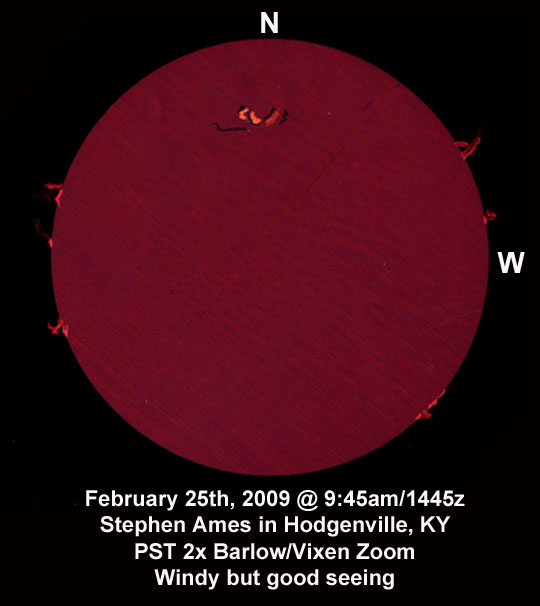
February 25th, 2009
Crayola Aqua Green pencil for proms
Crayola Cerulean for Plage
White Conti Pastel for filaments
white 20# paper with Aqua Green disk
I scan into photoshop and invert.
PST 2x Barlow and Vixen Zoom
Blue skies,
Stephen A. Ames
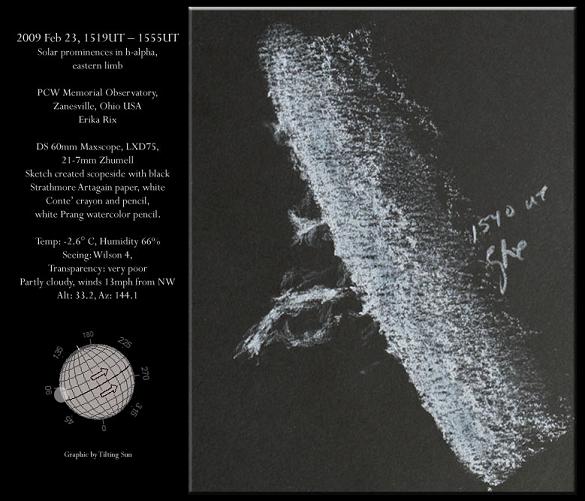
Solar Prominences February 23, 2009
Sketch and Details by Erika Rix
Solar prominences in h-alpha, eastern limb
PCW Memorial Observatory, Zanesville, Ohio USA
Erika Rix
DS 60mm Maxscope, LXD75, 21-7mm Zhumell
Sketch created scopeside with black Strathmore Artagain paper, white Conte’ crayon and pencil, white Prang watercolor pencil.
Temp: -2.6° C, Humidity 66%
Seeing: Wilson 4, Transparency: very poor
Partly cloudy, winds 13mph from NW
Alt: 33.2, Az: 144.1
A fairly tall prominence stood out on the eastern limb that looked like a pair of hands loosely pressed together in prayer. Par for the course on these larger delicate features, they look almost detached until you concentrate on that area for a more in depth look. This is the prominence I concentrated on for the observation sketch. There was another smaller prom just north on the western limb close to a position angle of 290-300 degrees. It consisted of two arches messed together with small spikes on the limb next to them. Another slender prominence worth mentioning was located on the southern limb.
A thick, squat filament was just inside the limb about 45 degrees further south than the sketched prominence on the eastern limb.
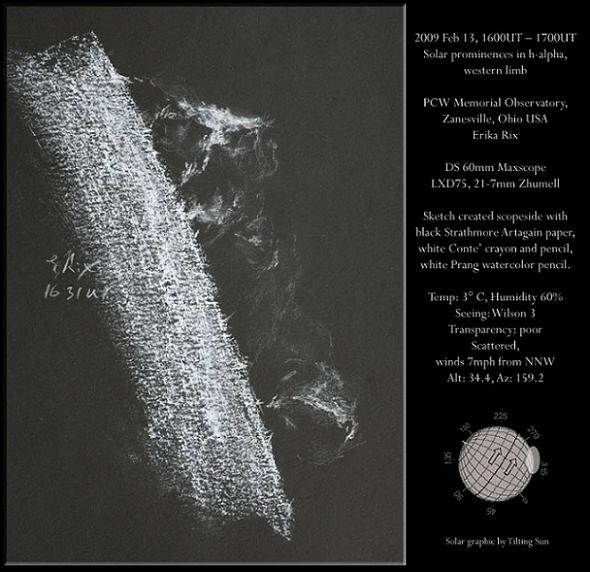
Solar Prominences on February 13, 2009
Sketch and Details by Erika Rix
2009 Feb 13, 1600UT – 1700UT
Solar prominences in h-alpha, western limb
PCW Memorial Observatory, Zanesville, Ohio USA
Erika Rix
DS 60mm Maxscope, LXD75, 21-7mm Zhumell
Sketch created scopeside with black Strathmore Artagain paper, white Conte’ crayon and pencil, white Prang watercolor pencil.
Temp: 3° C, Humidity 60%
Seeing: Wilson 3, Transparency: poor
Scattered, winds 7mph from NNW
Alt: 34.4, Az: 159.2
Approximately 30° inward from the eastern limb, a crescent-shaped plage was seen with a dark dot during my h-alpha observation. No AR was noted in white light. There were a few proms scattered about to the north and south, but the prominences on the western limb really stood out. At first glance it looked like two detached proms, but adjusting the outer etalon and increasing magnification, that section of limb came alive with prominence structure.
North is to the 4.5 o’clock position and west is the 2.5 o’clock position in my sketch.
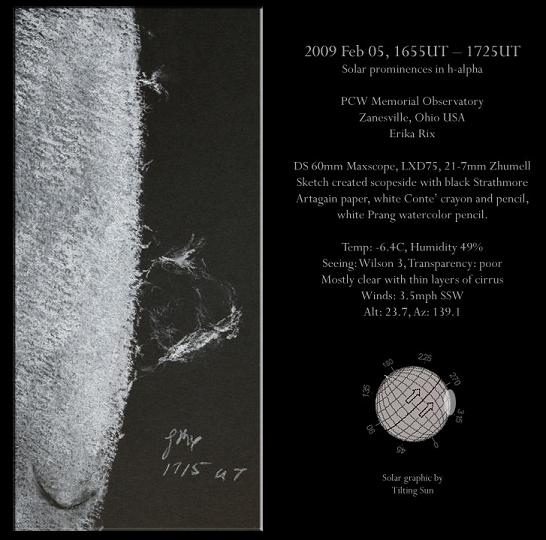
Solar prominences 2009 Feb 05, 1655UT – 1725UT
Sketch and Details by Erika Rix
2009 Feb 05, 1655UT – 1725UT
Solar prominences in h-alpha
PCW Memorial Observatory, Zanesville, Ohio USA
Erika Rix
DS 60mm Maxscope, LXD75, 21-7mm Zhumell
Sketch created scopeside with black Strathmore Artagain paper, white Conte’ crayon and pencil, white Prang watercolor pencil.
Temp: -6.4C, Humidity 49%
Seeing: Wilson 3, Transparency: poor
Mostly clear with thin layers of cirrus, Winds: 3.5mph SSW
Alt: 23.7, Az: 139.1
There was an area that I suspected was a new AR just NW of center while observing in h-alpha. It appeared to have two small plage with a single tiny sunspot to the west of them. After pulling out the ETX70 with a white light filter, all that I could see were moments of visible granulation and there were neither faculae nor pores to be seen.
To the south, in h-alpha, there was a very bright smaller prom with several tiny fingers of proms around it. Heading about 30 degrees west around the limb I noticed a thick medium sized prom that was very faint and the base of it was nearly impossible to see.
On the NW limb were two slender proms that on closer inspection it was obvious that they were actually one intricate arch of a prominence with delicate tendrils attaching at different points within it. A filament was visible to the north of it, nearly reaching to the limb.
Other than a short thick filament to the north about 15 degrees in from the limb, as well as a few tiny proms not already mentioned, I just soaked in the surface view and called it a day.
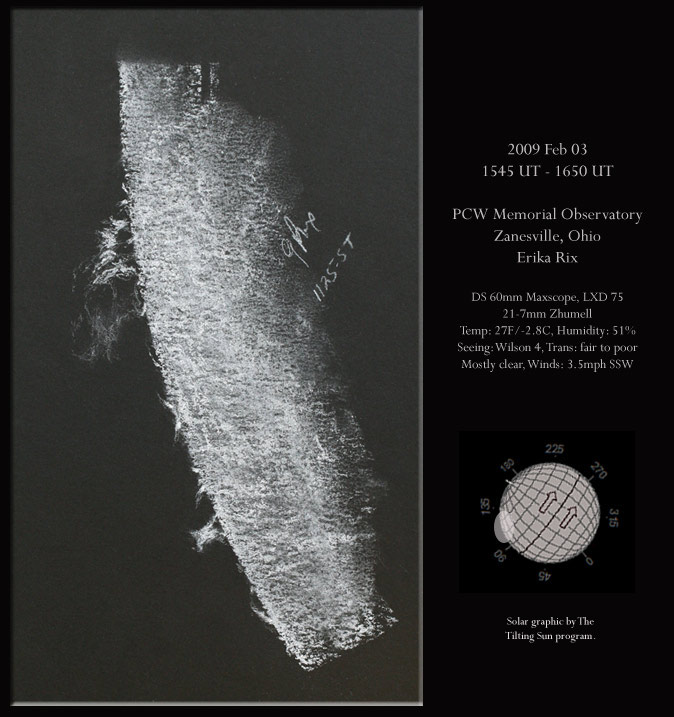
Solar Prominences at PA 120 degrees on February, 3rd, 2009
Sketch and Details by Erika Rix
2009 Feb 03
Solar
PCW Memorial Observatory, Zanesville, Ohio USA, Lat 40.01/Long -81.56 Erika Rix
What first appeared as a loop close to PA 120 degrees, became a beautiful structure with intricate fingers creating an arch. Then looking to south of it in my view (which would be heading north solar orientation wise) was a very large, faint addition to the prominence. Thankfully seeing was good enough today to increase the magnification for a closer look. It topped out close to 57x mag at Wilson’s scale of 4.
I used Strathmore Artagain, Conte’ crayon and pencil, Prang watercolor pencil. I took a photo of it in the shade rather than using the scanner. It seems to reproduce the black paper sketches best for me.
The solar graphic was from the Tilting Sun program.
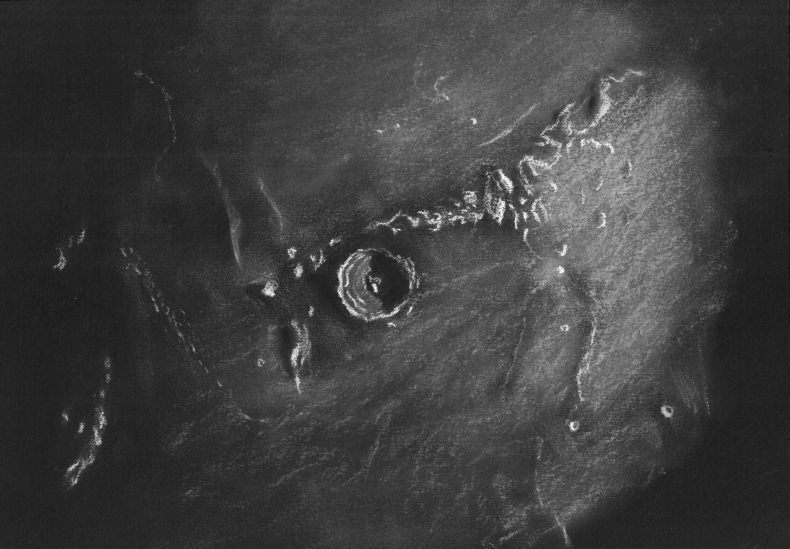
Eratosthenes Crater and the Montes Apennius
Sketch and Details by Aleksander Cieśla
Eratosthenes crater and the Apennines Mountains on the Moon’s surface.
Object: Moon – Eratosthenes Crater
Scope: Schmidt-Cassegrain 5” + Speers-Waler 7,4mm + barlow 1,6x
Filter: Moon&SkyGlow
Place: Poland, Wroclaw – near city center
Weather: Good. Seeing 7/10. Light Pollution.
Date: 6-7 January 2009
Technique: White pastel crayons on black paper
Tooling: N/A
The sunspots of Active Region 1007
Sketch and Details by Michael Rosolina
The Sun has been very quiet for months now as we are in solar minimum but there are signs that new Solar Cycle 24 is beginning. Active regions of a new solar cycle typically appear at high solar latitudes and have a polarity reversed from active regions of the old cycle.
The sunspots of Active Region 1007, rendered in this white light sketch, has these characteristics. It appeared at a high latitude and magnetograms revealed its reversed polarity. In addition, AR1007 was the fourth active region in a 30 day period to meet these requirements. Solar observers around the world are happily anticipating more activity in the coming weeks and months.
I used 15×70 binoculars equipped with Baader AstroSolar film filters to observe the Sun for this sketch. (Remember–NEVER look at the Sun directly–always use filters or telescopes specifically designed for solar observing) HB and 2B pencils were used for the sunspots and a blending stump was used to darken the solar limb. The template is a 100mm circle.
Object Name: The Sun/AR1007
Object Type: Active region sunspots
Location: Friars Hill, WV USA
Date: 2 Novenmber 2008
Solar Prominence
Sketch and Details by Jeff Young
My permanent pier is a bit high for this time of year (when the sun is so low to the horizon), so I had to rotate the binocular head a bit to see through it. The sketch orientation therefore doesn’t match the sun graphic (courtesy of Tilting Sun by Les Cowley) in the upper right.
I’ve only been doing solar sketches for about 6 months now, but this was definitely the most fun to sketch so far. Conditions were pretty poor (with seeing alternating between bad and horrible, and transparency not much better), but there was gobs of detail to take in and try to reproduce.
White Derwent Graphitint pencil on black Artagain paper. Solarscope 70mm h-alpha filter / Tele Vue Pronto / Astro-Physics Barlow / Baader MkV binoviewer / Tele Vue 19mm Panoptics / Astro-Physics 400QMD equatorial mount. 10-Oct-2008; 10:20UT; County Louth, Ireland.
Solar Prominence
Sketch by Serge Vieillard
Serge Vieillard created this H-Alpha Prominence sketch as a negative. He added color digitally after scanning and inverting the original drawing.
Solar NOAA 11003
Sketch and Details by Erika Rix
2008 Oct 05
Solar – featuring SE quadrant and NOAA 11003
Erika Rix, PCW Memorial Observatory, 40.01/-81.56
Observation details:
AR 11003 was not visible to me in white light using my ETX70 with a TV8mm plossl. I did see granulation on and off, transparency isn’t too great today. I almost thought I detected this region briefly, but couldn’t confirm it.
In h-alpha using my Maxscope, the area was lit up very nicely by bright slender plage making some of the background around it appear darker in comparison to the rest of the disk. I didn’t see any sunspots within the active region.
There were many prominences scattered around the limb and a very short, almost spot-like filament in the southern hemisphere west of the AR.
Sketch details:
This case is a perfect example of getting carried away with fitting in all the details and then losing touch on size and contrast. The active region was smaller in real life and a little further away from the limb. I continued on with the sketch anyway, marking the error in my report and off to the side of the sketch, since it was still an accurate representation of the AR within itself.
The prominence set on the limb is accurate in size, but I rendered it too bright, again getting carried away with my markings while trying to mark in the details within the prom.
Even though I’ve made the errors, I’ve marked them accordingly and still have a successful sketch from my observation. I say successful because I’ve still achieved my goals of in depth study of the Sun through sketching and managing to record my observations of these features regardless of two areas of errors that I stated. Sometimes sketching can be like patting your head and rubbing your belly at the same time. The results can make you giggle, but you still trying your hand at it.
I grabbed the black paper closest to me today, so that was the Artagain paper. White Conte’ chalk, Conte’ pencil, and white Prang pencil were for the white areas. Contrast added with a stick of charcoal and a black pen. No erasing was done and blending of the solar surface was done with my finger tips. No blending was done after that.
I added a -15 brightness after taking a photo of my sketch with my Rebel outside in diffused lighting. My new scanner is still giving me fits scanning in my sketches, so I find it easier to take photos of them until I can master the new machine. Taking a little more time out of my day than I should have for fun, I managed white light and h-alpha viewing.